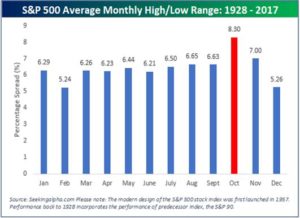Equity Market Volatility-A Historic Look at the Fall
- 04
- Sep
Heading into September, The Dow Jones Industrial Average is within striking distance of a record, and the S&P 500 and NASDAQ hit all-time highs in August. In August, the S&P 500 index broke the record for the longest U.S. bull market in history. This bull market run is over 3,500 days, with equities rising over 320% since it began on March 9, 2009. It’s a record few would have predicted when stocks struggled to find their footing after a 50% plunge during the financial crisis. Even after this impressive achievement, there is no shortage of bearish warnings as analysts debate the future. Many investors continue to feel there is plenty of gas left in the tank for equities.
While 2017 proved to be a very healthy and non-volatile year on Wall Street, in 2018, volatility returned. The first quarter of the year reminded investors that volatility will always be a part of the markets and investing.
Stocks are at all-time highs, but historically, a tough time for the equity market is approaching. Some driving factors in volatility’s strong comeback in 2018 are rising interest rates; inflation; geopolitical uncertainty and global trade issues (including tariffs). Market observers noted that by April, for 2018, the S&P had moved at least 1% about 40% of the time. That is the most moves of 1% since 2009 (cnbc.com).

Even with volatility back in action, the markets have advanced and throughout the summer, 2018 has been kind to investors. As we look ahead, the fall is a time where investors have seen a bumpy ride. A long-range study from 1928 to 2017 found that October and November are historically the months of the year with the biggest share of 1% day moves (up or down) in the S&P 500, with October having a decisive 1.3% lead over November.
The good news from this study is that when the S&P 500 has gains in August and September, it historically has rallied through the end of the fourth quarter for a 2% average gain.
“Whenever the S&P 500 has been up in August and September, two months that are usually very challenging for stocks, the S&P 500 has risen in price 13 of 16 times, or 81 percent of the time, for the remainder of the year,” said Sam Stovall, chief investment strategist at CFRA (cnbc.com).
However, investors know that no one can predict the future, and past performance is no assurance of any financial return. Volatility is a part of investing and instead of being worried by volatility, the best plan of action for volatile times is preparation. Most analysts are cautioning for a possible pullback or correction in equity prices, but not signaling a recession. One of the best analogies we have seen is that the forecast for equities looks sunny with a chance of rain.
Fall Volatility – Three of the Worst Cases in History
While most experts are saying it is very unlikely that the fall of 2018 will produce a crash in the equity markets, some of the most dramatic equity drops of all time came during the fall. Three notable instances were:
Black Tuesday 1929
The stock market crash of Oct. 29, 1929, marked the start of the Great Depression and sparked America’s most famous bear market. The S&P 500 fell 86 percent in less than three years and did not regain its previous peak until 1954.
Black Monday 1987
The S&P 500 lost almost 30% during 39 trading days in 1987. However, in just one day, on Monday, October 19, 1987, the Dow Jones Industrial Average (DJIA) lost 23%, the worst day since the Panic of 1914. This bear market was short (compared to others) and long-term investors were rewarded with an 845.2% return over the next 13 years.
September 29, 2008
The DJIA fell 777.68 points. Up until this year when the DJIA closed down 1,175 points on February 5, 2018, it was the largest point drop in history. This was predicated by major news like Lehman Brothers declaring bankruptcy and the Fed announcing bail-outs. The fourth quarter of 2008 also had additional large one-day points drops, including 678.91 on October 9, 733.08 on October 15, and 679.5 on December 1 (NBCnews.com; The Motley Fool; the balance.com; businesesinsider.com).
Tips for Savvy Investors
Markets rise and they also retreat. That is part of the investment experience. Being prepared for any future circumstances that may occur can be helpful. Focusing on your personal investment goals can be key to long-term financial success. Sometimes, this can be easier said than done, especially with all the external noise investors receive.
As we head into a quarter historically unnerving for investors, let’s recap key points that can help keep you grounded if we experience turbulent times.
Tune Out Media Magnification
One of the biggest challenges investors face is how to tune out the magnification of financial issues by the media. Adhering to a long-term investment plan often requires taking the news with a grain of salt and putting the impromptu advice of others on the back burner. Too often emotion, not logic, rules on investing habits, so the first step in declaring this mental independence is realizing how these influences, known as biases, affect us.
It can be difficult to make rational investment decisions when the markets are fluctuating. During these times, it is prudent to resist the temptation of watching news reports and obsessively watching portfolio performance. Sometimes, the more information you have, the more likely you could make a decision that deviates from your long-term strategy.
Avoid the Herd Mentality
A powerful influence to avoid is the herd mentality. Especially in today’s easy access to information through multitudes of news sources and media outlets, one can be easily influenced by potentially misleading information and actions, and abandon reason and simply follow the crowd. Once you are aware of this pitfall, it is important to avoid it and remain focused on executing an investing strategy that is most appropriate for your situation.
Sometimes the most difficult thing to do in investing is nothing at all. Nobel Laureate Daniel Kahneman, considered the father of behavioral economics, suggests that, “we would be better investors if we just made fewer decisions.”
Consider These Three Questions
As we all know, in times of crisis, many people tend to overreact and sometimes do not make the best decisions. Should the markets experience unnerving fluctuations, we suggest you ask yourself three questions:
-
Have my financial timelines changed?
-
Have my financial goals changed?
-
Has my risk tolerance changed?
If you answered “YES” to any of these questions, then it is wise to discuss these changes with us. One of our primary responsibilities as your financial advisor is to consistently keep in touch with you and monitor your situation.

Think with Your Head, Not Your Emotions.
One of Sir John Templeton’s “Rule’s for Investment Success” is, “Do not be fearful or negative too often.”
If there is market turbulence, it should remind us it is a good idea to re-evaluate instead of panic. Revisiting your current financial situation and evaluating if your risk tolerance, goals and needs are still congruent with your time horizon is a wise plan of action. We try to do this at your next review, but if you feel you would like to do this sooner, do not hesitate to call us.
Seek the Help of a Professional
One of our primary goals is to make sure you are comfortable with your investments. Peaks and valleys have always been a part of financial markets. Even if your time horizons are long, you could see short-term movements in your portfolios in the fourth quarter. Rather than focusing on the turbulence, you might want to make sure your investment plan is centered on your personal goals and timelines.
We will always consider your feelings about risk and the markets and review your unique financial situation when making recommendations.
We pride ourselves in offering:
-
consistent and strong communication,
-
a schedule of regular client meetings, and
-
continuing education for every member of our team on the issues that affect our clients.
A skilled financial advisor can help make your journey easier. Our goal is to understand our clients’ needs and then try to create a plan to address those needs. If you need to discuss your investments, please call us!
As always thank you for your confidence in our firm!
Complimentary Financial Check-up
If you are currently not a client of Financial Advisors Network, Inc., we would like to offer you a complimentary, private consultation with one of our professionals at absolutely no cost or obligation to you.
To schedule your financial check-up, please call us at (714) 597-6510 and we would be happy to assist you.
Financial Advisors Network, Inc. is a Registered Investment Adviser. This post is solely for informational purposes. Advisory services are only offered to clients or prospective clients where Financial Advisors Network, Inc. and its representatives are properly licensed or exempt from licensure. Past performance is no guarantee of future returns. Investing involves risk and possible loss of principal capital. No advice may be rendered by Financial Advisors Network, Inc. unless a client service agreement is in place.
This article is for informational purposes only. This information is not intended to be a substitute for specific individualized tax, legal or investment planning advice as individual situations will vary. For specific advice about your situation, please consult with a tax professional or financial professional. Sources: www.cnbc.com; seekingalpha.com; The Montley Fool; the balance.com; businessinsider.com. This article provided by the APFA © 2018
- Financial Advisors Network Customer Service
- Articles, Uncategorized
- Tagged with : Financial Services, Market Volatility
- Comments Off on Equity Market Volatility-A Historic Look at the Fall





